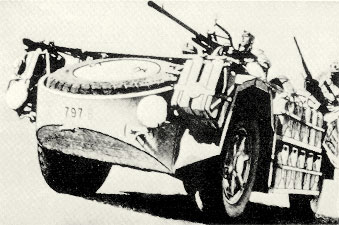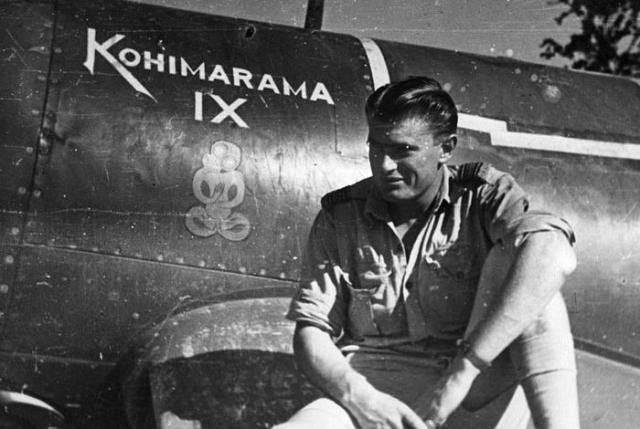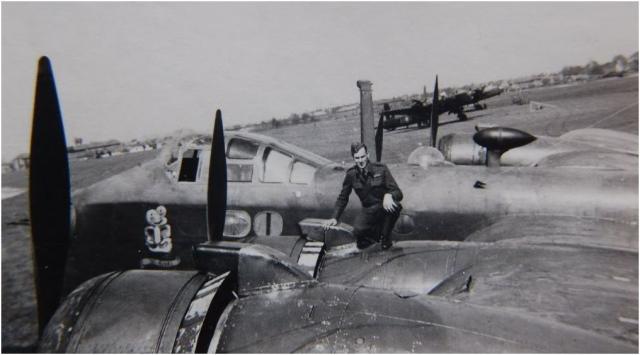Continuing on from The New Zealand Tiki Squadrons (1) there were further examples of tiki art in use by the New Zealand military (in both the RAF and the RNZAF) during World War II. Next up is No. 135 Squadron RAF stationed in India in 1943, which flew Hurricanes. It’s not clear exactly how many New Zealanders operated in this squadron but the specific Hurricane pictured was flown by Pilot Officer WH “Hugh” Dean of the RNZAF. Continue reading “The New Zealand Tiki Squadrons (2)”
Category: WW2 History
The New Zealand Tiki Squadrons (1)
A friend of mine has been researching the use of tiki symbolism in New Zealand prior to the 1950’s, and most notably it’s use in military units and formations. A German author, Sven Kirstin, has written 3 books about tiki pop culture (published by Taschen), claiming that this was somehow a unique cultural invention particular to the United States. Despite the fact it has been pointed out to him that white New Zealanders adopted the tiki as a popular culture icon on postcards, book covers, stamps, ashtrays, cigarette lighters, mugs etc. decades before white Americans did, he has failed to mention this in his books and persists in his view that it’s a unique cultural feature of the USA that originated around the 1950’s. Continue reading “The New Zealand Tiki Squadrons (1)”
U.S. Army 1944 Firing Test No.3
U.S. Army Firing Tests conducted August 1944 by 12th U.S. Army Group at Isigny, France.
Board of Officers
APO 655
30 August 1944
SUBJECT: Final report of board of officers appointed to determine comparative effectiveness of ammunition of 76mm gun and 17pdr gun.
U.S. Army 1944 Firing Test No.2
Firing Tests conducted 12-30 July 1944 by 1st U.S. Army in Normandy.
REPORT OF PROCEEDINGS OF BOARD OF OFFICERS
Organization: Headquarters, First U.S. Army.
Place: APO 230, U.S. Army.
Proceddings of a board of officers which convened at Headquarters, First U.S. Army, pursuant to Special Order No.196, Headquarters, First U.S. Army, 19 July 1944, a copy of which is attached as Exhibit A1.
U.S. Army 1944 Firing Test No.1
Report on Comparative Firing Program Witnessed at Shoeburyness, Essex, 23 May 1944 by U.S. Army Headquarters ETO representatives.
ARMORED FIGHTING VEHICLES & WEAPONS SECTION
APO 887
319.1 – 24 May 1944
MEMORANDUM TO: Executive Officer, AFV&W Section, Hq., ETOUSA.
SUBJECT: Report on Comparative Firing Program Witnessed at Shoeburyness, Essex, 23 May 1944.
Effectiveness of British (& U.S.) Tank Guns
Effectiveness of Guns and typical AFV Ammo Loads in British Service (including some U.S. Types).
This is a 1944 British War Office Document.
Continue reading “Effectiveness of British (& U.S.) Tank Guns”
Determining Shot Penetration Characteristics
The penetration of AP (Armour Piercing) Shot is determined primarily by its weight and velocity at the moment of impact. Other factors can influence it’s velocity (such as wind, pressure and atmospherics), or its ability to “bite” into the armour (e.g. ballistically curved surfaces, such as the T-34 turret or Porsche King Tiger Mantlet, or different shaped projectile heads, can cause rounds to ricochet). Finally the angle of the target’s armour, along with the firer’s angle of shot can affect the relative thickness of armour presented to the round that will need to be penetrated.
Continue reading “Determining Shot Penetration Characteristics”
Table of Compound Angles of Impact


The Angle of Impact on Armour Plate with the Angle of Attack in the Horizontal Plane
Formula: Cosine (Compound Angle) = Cosine (Vertical Angle) x Cosine (Horizontal Angle)
This information above was supplied to me by Jim O’Neil (Arizona, USA), the original source was Lorrin Bird. I’ve added a couple of quick comments below in the Notes section.
Effect of Hardness upon resistance to Penetration
An increase in the hardness of a given thickness of homogeneous armour may result in an increase or in a decrease or in no change at all in resistance to penetration, depending upon the ratio of the thickness of the armour to the calibre of the projectile concerned. Where under-matching projectiles (those whose calibre is less than the thickness of the armour) are concerned resistance to penetration at normal impact increases as hardness increases; where overmatching projectiles (those whose calibre is greater than the thickness of the armour) are concerned, resistance to penetration at normal impact decreases as hardness increases; and where matching projectiles (those whose calibre equals the thickness of the armour) are concerned, little change in resistance to penetration at normal impact occurs over a considerable range in hardness.
Continue reading “Effect of Hardness upon resistance to Penetration”
Sahariana: “The Desert Jeep”

As used by Italian Reconnaissance Groups
Designation
Officially the Camionetta 42 ‘Sahariana’ – however, they are also referred to as – Camionetta ‘Sahariana’ AS 42 – or – Camionetta SPA 43 ‘Sahariana’ – (and incidentally the word Sahariana is singular, so if you are talking about more that 1 vehicle it is ‘Sahariane’).
The letters AS are the Italian code for North Africa, “Africa Settentrionale“, which pretty literally translates as “North African” but is often translated as “African Service” in English texts. Any equipment, unit organization, or formation that was designed or organized specially for North Africa was given this designation. In this case, it refers to the mechanical specifications of the vehicle being able to handle the harsh environment.
Giovani Fascisti: The “Young Fascists” (GGFF)
Gruppo di battaglioni GGFF – Giovani Fascisti
(at Bir el Gubi, November 1941)
GRUPPO GGFF HEADQUARTERS COMPANY
GRUPPO GGFF MG COMPANY
COY HQ
3 MG PLATOONS (each 3 x MMGs)
Continue reading “Giovani Fascisti: The “Young Fascists” (GGFF)”
Camicie Nere: The Blackshirts (MVSN & CCNN Combat Units)
M.V.S.N – The Milizia Voluntaria per la Sicurezza Nazionale
The MVSN started out as an organization not unlike the German S.A. (Brown Shirts), i.e. a Fascist Militia. They were purely a “Party” orientated organization, and like their German Counterparts wore a distinctive uniform – a Black Shirt and a Fez. This led to their popular nickname of Black Shirts (Camicie Nere – Camicie = Shirt & Nere = Black). Later the term CCNN was adopted for Black Shirt military units, and is taken directly from the initials of Camicie Nere. MVSN and CCNN are generally interchangeable, however the former primarily refers to political orientated parts of the Black Shirts, while the latter is generally used in reference to combat units.
Continue reading “Camicie Nere: The Blackshirts (MVSN & CCNN Combat Units)”

